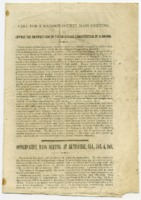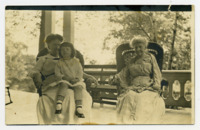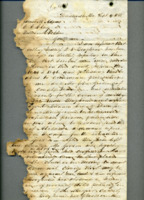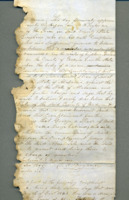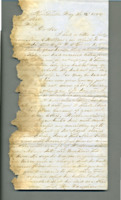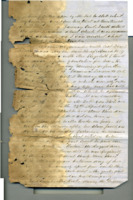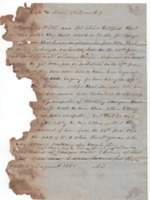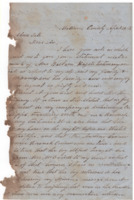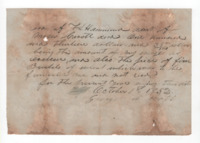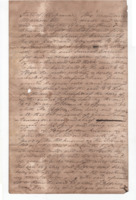
Browse Items (56 total)
Sort by:
-
"Call for a Madison County Mass Meeting, to Oppose the Ratification of the So-Called Constitution of Alabama."
This broadside was published by conservative Alabamians in opposition to the 1868 Alabama constitution, known as the "Reconstruction Constitution." The constitution was revised by the constitutional convention on November 5, 1867, and ratified in 1868. -
Postcard of a woman, possibly Virginia Clay-Clopton, and companions.
The back of this real photo postcard reads, "Virginia Clay Clopton, age 90." -
Letter to James M. Adams, C. C. Clay, and William Acklen from Abner Tate.
This letter, written on September 4, 1855, contains information regarding several murders the occurred at the [sic] House between 1841 and 1846, as reported by D. H. Bingham. He further details the arrest and imprisonment of a Mr. John Gordon in relation to the murders, and his appearing in court. Possible information regarding the burial of the murdered men are offered in the letter as well. The letter ends with Abner Tate discussing the validity of certain confessions as many "delight" in "destroying the reputations of others." -
Statement Letter of D. H. Bingham.
This is the statement of Daniel H. Bingham taken in December of 1855 regarding a murder that occurred in Alabama that occured in 1842. In his statement, D. H. Bingham accuses Abner Tate of the murder of one Jonathan K. Rier of Tuscaloosa. He also accuses Tate's slave, George Cabiness, of aiding and abetting in the committing of the crime. Following Bingham's statement, a statement of support is taken from Barbara Hazel placing a "stranger" in the home of Abner Tate the night of the murder. The next page is a second statement given by D. H. Bingham regarding the murder of Charles B. Sawyer of Coffee County, Tennessee and accusing Abner Tate and his slave, George Cabiness of the crime. His statement is followed by the witness, Barbara Hazel's statement that placed the victim in the home of Abner Tate. -
Letter Regarding the Case and Barbora Hazle's Statements.
This letter, written on May 12, 1856, has several names that are illegible, including the author's. It is addressed to two men, the first being [Daniel] P. Pool, and is a lengthy letter in response to a letter received from Abner C. Wellborn and in particular, the supporting testimony of Barbara Hazel accusing Abner Tate of at least two murders. The author states that the credibility of Hazel's words should be questioned due to the several reasons he goes on to detail. Following the original letter, the author pens an amendment to include changes that occured since the original letter was written as Tate had made a recent publication during that time. -
Testimony of a Resident of Elizabeth Routt as Requested by Abner Tate.
The author of this written statement is illegible. It appears that the first name of the author may be Francis but it being so faded, is difficult to discern. The author does state that he was living with Elizabeth Route at the time and managing her plantation, during which he became aquainted with Daniel H. Bingham. The written statement, recorded as the author was "called upon by Mr. Tate to state what my testimony was upon his trial...", details the interaction of the author with Bingham, who wished to marry Mrs. Routt, and Mrs. Routt, beginning in March 1854 through 1855. -
Note to Moore's Statement.
The Note to Moore's Statement was signed A.T., alluding to the possibility that Abner Tate wrote this. The note discusses the testimony of Mrs. Willis and Colonal Sheid regarding a search for Sawyer, one of the murdered men. It traces Sawyer's known whereabouts prior to him going missing. The note claims that A.T. had never heard of Sawyer or Rein, the second victim, until August 1855. -
Letter to Abner Tate.
The letter to Abner Tate addresses the testimony of Barbara Hazel, confirming some parts but refuting more of it. It is clear that pages of the letter are missing as it ends in the middle of a sentence and has no author's signature on any page. Note: This could be Moore's statement which would match with the Note to Moore's Statement. -
Receipt of George W. Scott.
This receipt is from October 1, 1852 and notes Scott's wages and the price of wheat bushels. -
Deed of Samuel Conner.
This deed was created and finalized on June 19, 1843 between Samuel Conner and Elizabeth Routt (then High) following the death of her third husband, Alexander Jeffries. This indenture gives Samuel Conner a sum of two hundred and thirty seven dollars for a parcel of land. The land would be the Jeffries plantation that Elizabeth would live on until after the death of her sixth husband, Willis Routt, and following the dismissal of her lawsuit against Abner Tate.
